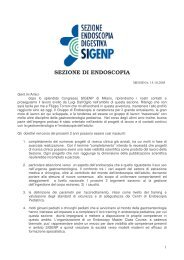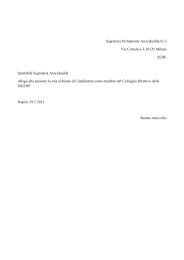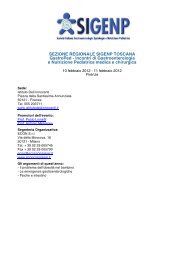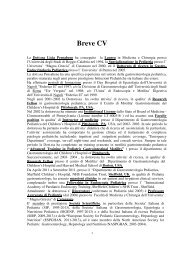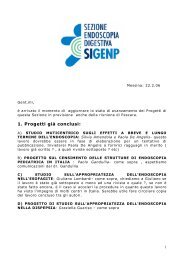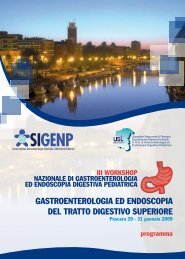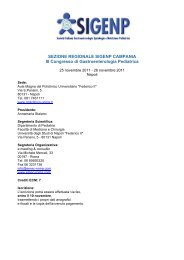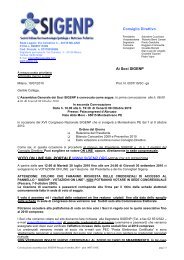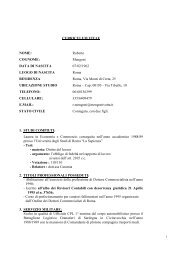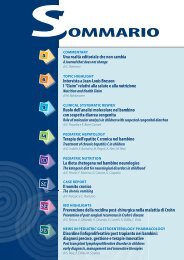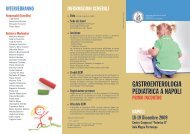La colelitiasi in età pediatrica. Il punto di vista del clinico - SIGENP
La colelitiasi in età pediatrica. Il punto di vista del clinico - SIGENP
La colelitiasi in età pediatrica. Il punto di vista del clinico - SIGENP
You also want an ePaper? Increase the reach of your titles
YUMPU automatically turns print PDFs into web optimized ePapers that Google loves.
Key Po<strong>in</strong>ts<br />
• Lo stu<strong>di</strong>o sc<strong>in</strong>tigrafico <strong>di</strong> svuotamento<br />
gastrico nell’adulto è<br />
stato <strong>di</strong> recente standar<strong>di</strong>zzato;<br />
è possibile utilizzare il protocollo<br />
raccomandato nelle l<strong>in</strong>ee<br />
guida per stu<strong>di</strong> <strong>di</strong> svuotamento<br />
gastrico nell’adolescente<br />
• Dati prelim<strong>in</strong>ari nell’adulto suggeriscono<br />
che potrebbe essere<br />
possibile una valutazione dettagliata<br />
<strong>del</strong>le <strong>di</strong>verse fasi <strong>del</strong>lo<br />
svuotamento gastrico: se queste<br />
evidenze sono confermate,<br />
l’esame sc<strong>in</strong>tigrafico <strong>di</strong> svuotamento<br />
gastrico potrebbe significativamente<br />
aumentare la sua<br />
sensibilità ed assumere nuovi<br />
ruoli<br />
• Lo stu<strong>di</strong>o <strong>di</strong> svuotamento con<br />
liqui<strong>di</strong> necessita ulteriore stu<strong>di</strong>o<br />
per uniformare protocolli<br />
<strong>di</strong> acquisizione e def<strong>in</strong>ire valori<br />
normali a seconda <strong>del</strong>l’<strong>età</strong><br />
24<br />
Tra<strong>in</strong><strong>in</strong>g and Educational Corner<br />
maco, mentre il vomito è prevalentemente associato con un ritardato svuotamento<br />
gastrico <strong>di</strong>stale (8).<br />
CONCLUSIONI<br />
<strong>La</strong> def<strong>in</strong>izione <strong>del</strong> pasto ra<strong>di</strong>omarcato e dei tempi m<strong>in</strong>imi <strong>di</strong> acquisizione <strong>del</strong>le immag<strong>in</strong>i<br />
nell’adulto rappresenta un passo avanti importante verso la standar<strong>di</strong>zzazione <strong>del</strong>l’esame<br />
<strong>di</strong> svuotamento gastrico con ra<strong>di</strong>oisotopi. Questi parametri possono utilizzarsi nell’adolescente.<br />
Lo stu<strong>di</strong>o <strong>di</strong> svuotamento gastrico con liqui<strong>di</strong> (usato soprattutto nel bamb<strong>in</strong>o<br />
<strong>di</strong> <strong>età</strong> <strong>in</strong>feriore a due anni) ancora necessita <strong>del</strong>la def<strong>in</strong>izione <strong>di</strong> un range <strong>di</strong> normalità e<br />
<strong>del</strong>la ottimizzazione <strong>di</strong> un protocollo <strong>di</strong> acquisizione. È necessario def<strong>in</strong>ire un range <strong>di</strong><br />
normalità con altri pasti ra<strong>di</strong>omarcati, a <strong>di</strong>verso contenuto calorico. È importante approfon<strong>di</strong>re<br />
il valore cl<strong>in</strong>ico <strong>del</strong>la caratterizzazione <strong>del</strong>le funzioni gastriche prossimale (fondo)<br />
e <strong>di</strong>stale (antro).<br />
BIBLIOGRaFIa<br />
1. Abell TL, Camilleri M, Donohoe K et al. Consensus recommendation for gastric empty<strong>in</strong>g<br />
sc<strong>in</strong>tigraphy: a jo<strong>in</strong>t report of the American Neurogastroenterology and Motility Society and the<br />
Society of Nuclear Me<strong>di</strong>c<strong>in</strong>e. Am J Gastroenterol 2008;103:753-763.<br />
2. Camilleri M, Breen M, Ryks M et al. Proximal and overall gastric empty<strong>in</strong>g of solids <strong>in</strong> patients<br />
with reduced gastric volume accommodation compared to matched controls. Dig Dis Sci 2011;<br />
56: 1729-1734.<br />
3. Tougas G, Eaker EY, Abell TL et al. Assessment of gastric empty<strong>in</strong>g us<strong>in</strong>g a low-fat meal:<br />
establishment of <strong>in</strong>ternational control values. Am J Gastroenterol 2000; 95:1456-1462.<br />
4. Ziessman HA, Bonta DV, Goetze S et al. Experience with a new simplified and standar<strong>di</strong>zed<br />
four-hour gastric empty<strong>in</strong>g protocol. J Nucl Med 2007;48:568-572.<br />
5. L<strong>in</strong> Z, Sarosiak I, McCallum RW. Optimal detection of gastroparesis. Am J Gastroenterol<br />
2006;101: S135.<br />
6. Delgado-Aros S, Camilleri M, Cremon<strong>in</strong>i F et al. Contribution of gastric volumes and gastric<br />
empty<strong>in</strong>g to meal size and postmeal symptoms <strong>in</strong> functional dyspepsia. Gastroenterology<br />
2004;127:1685-1694.<br />
7. Karamanolis G, Canepeel P, Arts J et al. Determ<strong>in</strong>ants of symptom pattern <strong>in</strong> i<strong>di</strong>opathic severely<br />
<strong>del</strong>ayed gastric empty<strong>in</strong>g: gastric empty<strong>in</strong>g rate or proximal stomach dysfunction? Gut 2007;<br />
56:29-36.<br />
8. Cuomo R, Sarnelli G, Grasso R et al. Functional dyspepsia symptoms, gastric empty<strong>in</strong>g and satiety<br />
provocative tests: analysis of relationships. Scand J Gastroenterol 2001;36:1030-1036.



